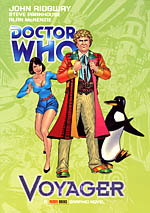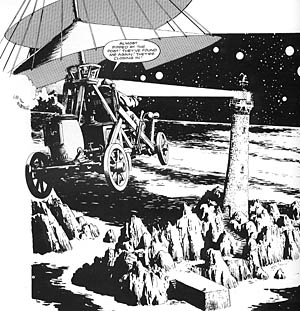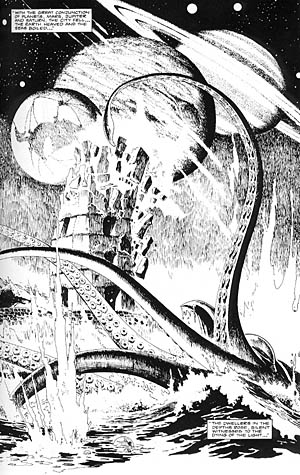 Written by Steve Parkhouse and Alan McKenzie
Written by Steve Parkhouse and Alan McKenzie
Art by John Ridgway
168 pages, black and white or color
Published by Panini Books
People who know me well can easily name my favorite two forms of entertainment—comic books and Doctor Who. With all that in mind, you’d think that with all of the various comic book version of Doctor Who out there, I’d be a happy camper, right? The reality, of course, is that just like most other media tie-in comics, the end result can be hit-or-miss at best. With Panini Books reprinting the comic strips to appear in Doctor Who Magazine over the years, though, I can say that there’s one reprint in particular I was overjoyed to see, and that’s Doctor Who: Voyager.
Joined by a new shapeshifting companion (that prefers the form of a penguin), the Doctor is having dreams… and disturbing ones at that. Then images from his dreams begin to appear, and the search for a series of star charts stolen from the Death figure known only as Voyager begins. But is it too late for the entire universe, and will all fall under the wrathful hand of Voyager?
 The first half of Doctor Who: Voyager is really the comic strip at its finest. Steve Parkhouse’s scripts for the first four stories (“The Shape-Shifter,” “Voyager,” “Polly the Glot,” and “Once Upon a Time-Lord”) in many ways are the example of how one can write a tie-in story to a currently-running show and still keep things interesting. The stories themselves, while all interconnected, each take on a different tone and genre. “The Shape Shifter” and its introduction of Frobisher is classic pulp noir, a pretty big contrast to the much more traditional science-fiction tropes of “Polly the Glot,” or the dreamlike, doom-laden “Voyager.” In the introduction to Voyager John Ridgway talks about how much more he’d enjoyed illustrating Doctor Who over Hellblazer (which he drew simultaneously) and it’s easy to see why. Parkhouse’s stories are full of wonderful ideas and imagery, from the abandoned sailing ship frozen on the edge of an ice-choked waterfall, to a shapeshifting alien sprouting up out of the central console of the TARDIS. Best of all, Parkhouse keeps a high level of suspense throughout his four stories in this volume, as both Voyager and Astrolabus are forever on the fringes of the action, always lurking, hiding, waiting to strike. The conclusion to Parkhouse’s run on the series, “Once Upon a Time-Lord,” not only wraps everything up but does it in style—one final burst of imaginative ideas about the nature of the stolen star charts, as well as a reflective look at not only the departure of the storyline but Parkhouse himself from the comic. Honestly, just reading the first half of Voyager you’ve more than gotten your money’s worth. (And who’d have thought the introduction of a penguin shapeshifter companion would be so popular? It’s a tribute to Parkhouse that the the character of Frobisher survived beyond him and was in many ways writer-proof, the character was so fun and beloved.)
The first half of Doctor Who: Voyager is really the comic strip at its finest. Steve Parkhouse’s scripts for the first four stories (“The Shape-Shifter,” “Voyager,” “Polly the Glot,” and “Once Upon a Time-Lord”) in many ways are the example of how one can write a tie-in story to a currently-running show and still keep things interesting. The stories themselves, while all interconnected, each take on a different tone and genre. “The Shape Shifter” and its introduction of Frobisher is classic pulp noir, a pretty big contrast to the much more traditional science-fiction tropes of “Polly the Glot,” or the dreamlike, doom-laden “Voyager.” In the introduction to Voyager John Ridgway talks about how much more he’d enjoyed illustrating Doctor Who over Hellblazer (which he drew simultaneously) and it’s easy to see why. Parkhouse’s stories are full of wonderful ideas and imagery, from the abandoned sailing ship frozen on the edge of an ice-choked waterfall, to a shapeshifting alien sprouting up out of the central console of the TARDIS. Best of all, Parkhouse keeps a high level of suspense throughout his four stories in this volume, as both Voyager and Astrolabus are forever on the fringes of the action, always lurking, hiding, waiting to strike. The conclusion to Parkhouse’s run on the series, “Once Upon a Time-Lord,” not only wraps everything up but does it in style—one final burst of imaginative ideas about the nature of the stolen star charts, as well as a reflective look at not only the departure of the storyline but Parkhouse himself from the comic. Honestly, just reading the first half of Voyager you’ve more than gotten your money’s worth. (And who’d have thought the introduction of a penguin shapeshifter companion would be so popular? It’s a tribute to Parkhouse that the the character of Frobisher survived beyond him and was in many ways writer-proof, the character was so fun and beloved.)
 That actually turns out to be a good thing, because new writer Alan McKenzie doesn’t have the same skills and finesse when it comes to the comic. It’s almost surprising to realize that McKenzie was Parkhouse’s editor on the comic, because the comic shifts tone so radically at this point it’s more than a little disappointing. His opening story “War-Game” seems to miss the basic fun of Doctor Who, and “Funhouse” is so by-the-numbers it’s hard to believe that even in mid-’80s a story with the Doctor regressing backwards through his timeline and the TARDIS being possessed hadn’t already been done to death. Concluding the volume is “Kane’s/Abel’s/The Warrior’s/Frobisher’s Story” which lurches from one plot point to the next; it felt like McKenzie was trying to go for the larger, more expansive picture that Parkhouse did so well; instead, the story just falls flat and feels oddly unfinished.
That actually turns out to be a good thing, because new writer Alan McKenzie doesn’t have the same skills and finesse when it comes to the comic. It’s almost surprising to realize that McKenzie was Parkhouse’s editor on the comic, because the comic shifts tone so radically at this point it’s more than a little disappointing. His opening story “War-Game” seems to miss the basic fun of Doctor Who, and “Funhouse” is so by-the-numbers it’s hard to believe that even in mid-’80s a story with the Doctor regressing backwards through his timeline and the TARDIS being possessed hadn’t already been done to death. Concluding the volume is “Kane’s/Abel’s/The Warrior’s/Frobisher’s Story” which lurches from one plot point to the next; it felt like McKenzie was trying to go for the larger, more expansive picture that Parkhouse did so well; instead, the story just falls flat and feels oddly unfinished.
The one consistent thing throughout Voyager, though, is Ridgway’s art. Printed in a magazine-sized format in its original black and white, you get an amazing amount of detail in his art, with lots of little individual locks of hair on the Doctor’s head, or individual wrinkles on the trunks of the stone elephants that flank the waterfall in Voyager’s realm. The scope of art on display here is lovely; when Astrolabus is piloting a Da Vinci flying machine towards a barren lighthouse across the ocean, you get a real sense of this being a big story, one able to go to expansive locations in a way that the television story never could. It’s also really impressive on how Ridgway is able to completely nail the likenesses of Colin Baker and Nicola Bryant without either of them coming across as stiff or posed, something that seems extremely hard to do when working with characters that are supposed to be real people. And while IDW is currently reprinting the Doctor Who Magazine comic in color and shrunken down to standard comic book size, I must say that I love the format that Panini Books chose; keeping the art as originally envisioned and at its proper dimensions really showcases just how much work went into these pages.
Despite the weak second half of Voyager (McKenzie’s tenure ended after one final three-part story), I’m absolutely delighted to have this book in my collection. These were the first stories that really made me understand that a tie-in story could be so much more (and while there are some enjoyable earlier stories as well, none had hit quite this level of excellence) and it’s fantastic to see a whole new audience being exposed to them. With a second, concluding volume of Sixth Doctor stories scheduled for later this spring (titled The World Shapers and including writers such as Jamie Delano, Grant Morrison, and Simon Furman), Voyager has made me really excited about its release. For those lamenting good Doctor Who comics, look no further than here.
Purchase Links: Amazon.co.uk
